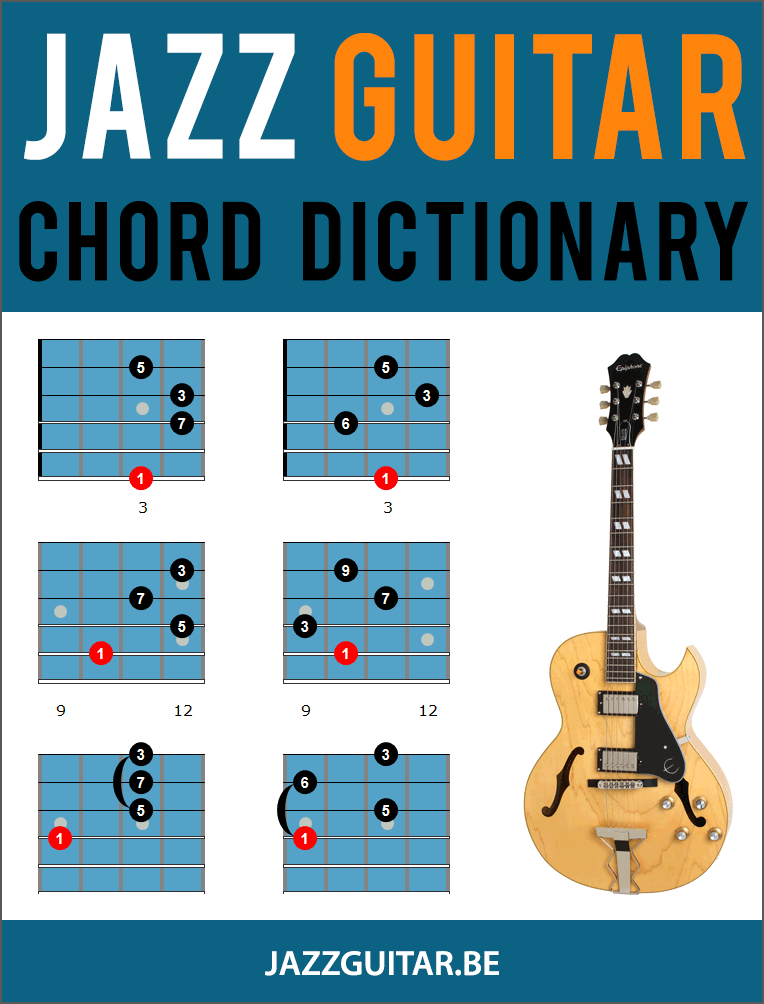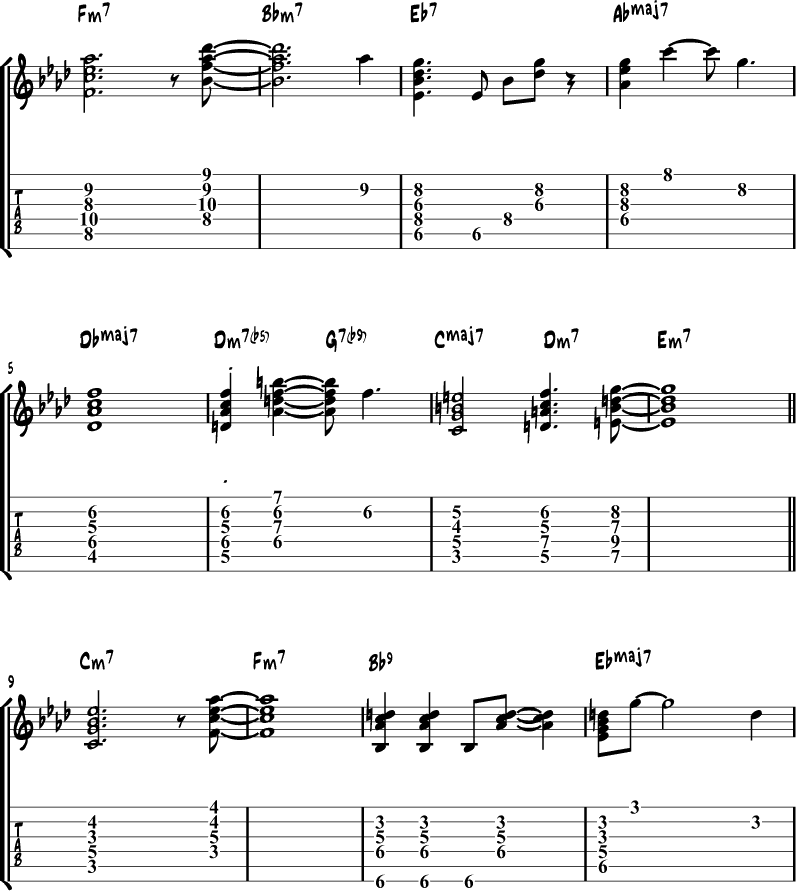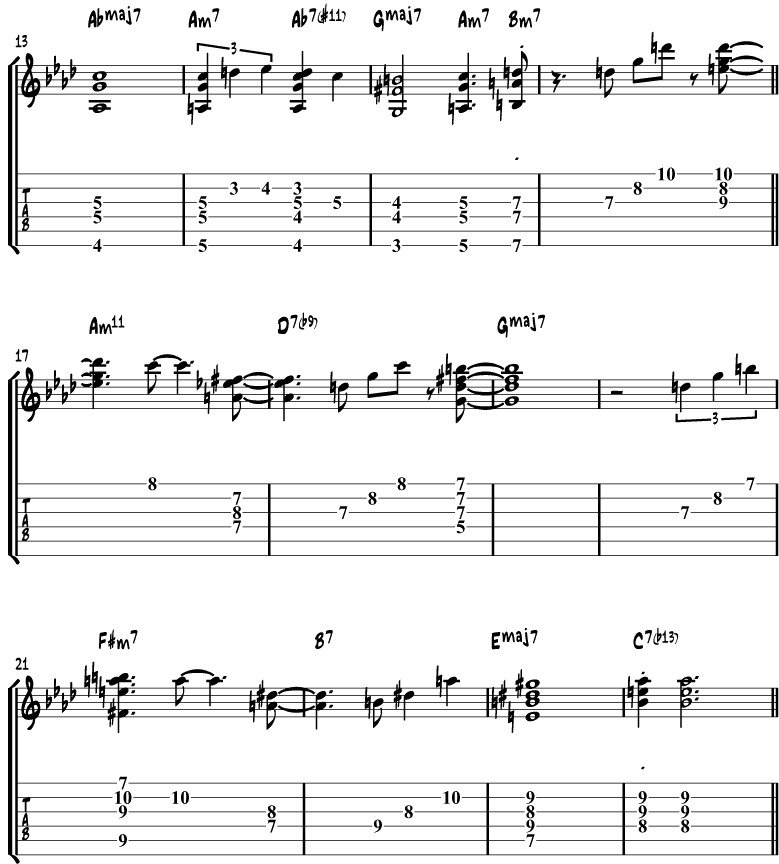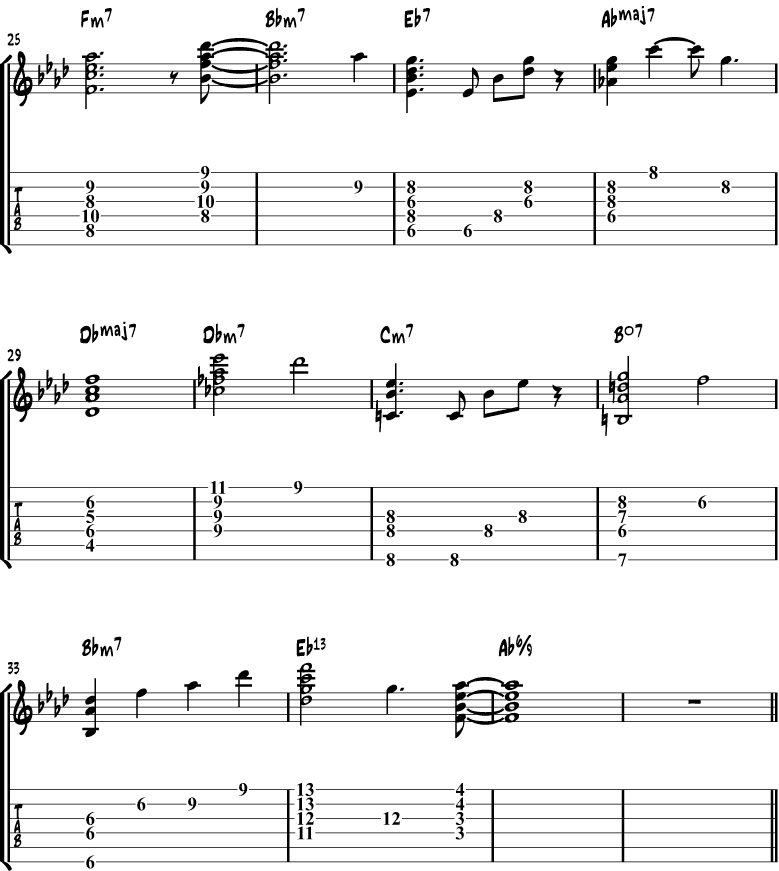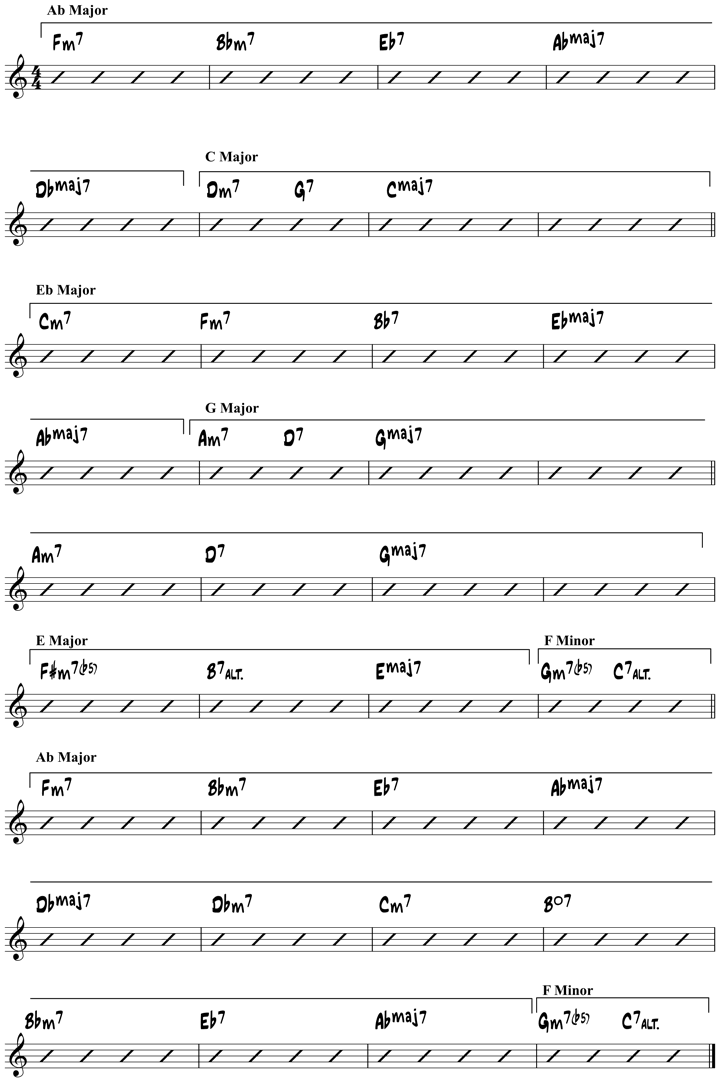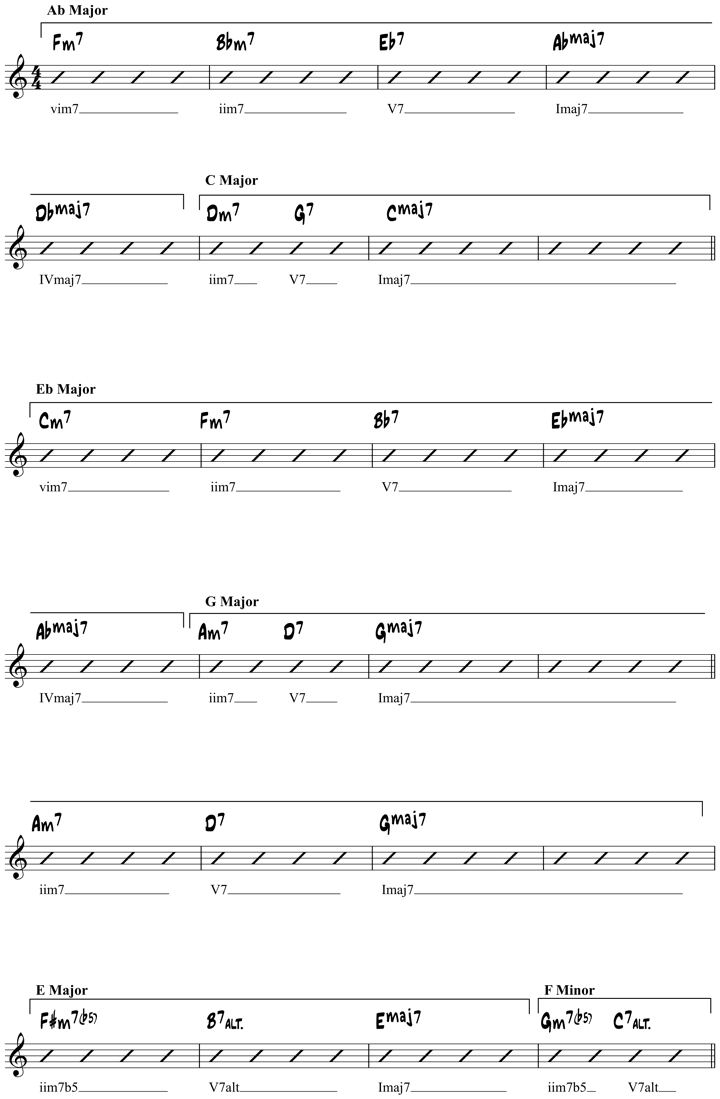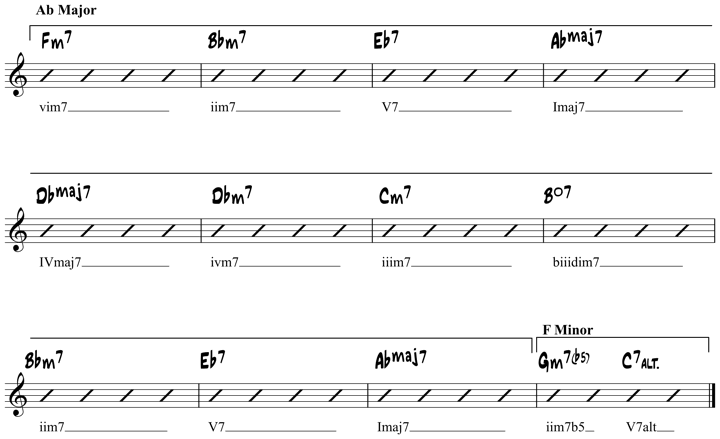- All The Things You Are
- LESSON CONTENTS
- All The Things You Are – Charlie Parker Intro
- All The Things You Are – Chord/Melody Arrangement
- All The Things You Are – Backing Track
- All The Things You Are – Key Center Breakdown
- A Section – Bars 1 to 8
- A’ Section – Bars 9 to 16
- B Section – Bars 17 to 24
- A” Section – Bars 25 to 36
- All The Things You Are – Roman Numeral Analysis
- ATTYA Common Chord Substitutions
- All the Things You Are — Intro, Chord Melody, Single-Note Solo & Chord Shapes
- Composed by Jerome Kern
- Tune’s History
- The Nuts and Bolts
- All the Things You Are: Introduction
- All the Things You Are: Comping Ideas
- All the Things You Are: Chord Melody
- All the Things You Are: Single-Note Solo
- All the Things You Are: Backing Track
- All the Things You Are: Chord Reference Sheet
- Suggested Listening
All The Things You Are
All the Things You Are (Jerome Kern) is one of the most commonly played jazz standards and is often one of the first tunes called at a jazz jam session. Because of the tune’s popularity, many guitarists learn to play All The Things You Are at a fairly early stage in their development. What most guitarists fail to realize is that the piece actually has a fairly intricate harmonic structure that can pose quite a few problems for the beginning improviser or comper.
By understanding the relationship between each section of the tune, and the chords within those sections, you can develop a greater appreciation for the overall formation of the harmony, which will allow you to better navigate the changes in both a solo and chordal fashion.
THE JAZZ GUITAR CHORD DICTIONARY (FREE eBOOK)
Download now and learn 244 chord shapes!
LESSON CONTENTS
All The Things You Are – Charlie Parker Intro
To begin this lesson, we’ll start with the famous intro Charlie Parker played on his recordings.
The intro starts on Db7#9 (tritone substitution of V/V), and then goes to C7#9, the V of the first chord of All The Things You Are (Fm7).
Here’s how you play it on guitar:
All The Things You Are – Chord/Melody Arrangement
Here is a chord/melody arrangement of the theme.
Listen & Play Along
All The Things You Are – Backing Track
Here is a backing track to help you get ATTYA’s chord changes in your ears and to improvise over. The backing track is done with Band in a Box, a great piece of software that lets you create backing tracks on the fly.
All The Things You Are – Key Center Breakdown
All the Things You Are can be divided into four sections, with the first two being sub-sections of one larger section:
A Section
The first section of the tune contains bars 1 to 8 and is labeled A.
A’ Section
This is followed by another eight-bar phrase that we will label A’. The ‘ symbol is used to differentiate this section from the first, as they are both very similar, but as you will see, they are in different keys.
These first two sections can also be thought of as the first “half” of the tune. In classical music, they would be called the exposition.
B Section
The third section contains bars 17 to 24 and will be labeled B. The B section is the “contrasting” section as it uses different keys and a different melody line than the other three sections.
In classical music, this section would be called the development section.
A” Section
The last section of the tune is similar to the first, though just a bit different, so we will label it A’’.
This section is used to “wrap” up the first two sections by restating the melody line in bars 25 through 29, before presenting new material that leads to the final cadence in bars thirty-three through thirty-five. In classical music, this section would be called the recapitulation.
A Section – Bars 1 to 8
There are two key centers found within the first eight bars of the tune, Ab and C:
There are two key centers found within the first eight bars of the tune, Ab and C:
- The first five bars contains a 6-2-5-1-4 progression in the key of Ab.
- This is followed by a 2-5-1 progression in the key of C.
Even though these chords are in two different keys, the fact that they are a half-step apart makes for a smooth modulation.
A’ Section – Bars 9 to 16
The next eight bars have a similar key structure as the first eight, though this time the two keys being used are Eb and G:
- The first five bars of this section is a 6-2-5-1-4 progression in the key of Eb.
- This is followed by a 2-5-1 progression in the key of G to finish the section. This is the same chord progression we saw in the first eight bars, only now it has been transposed down by the interval of a perfect fourth.
Thinking of the second eight bars as a transposed version of the first eight will allow you to develop motivic ideas over the first half of the tune. Anything you play over the first eight bars can be played over the second eight bars, just a fourth lower, or a fifth higher depending on how you want to think about it.
See the examples below for a sample of how this could be done. Notice how the fingering and the intervals are the same between the two lines, the second motive has just been moved up the neck to fit the new key center.
Bars 1 – 4
Bars 9 – 12
B Section – Bars 17 to 24
Bars seventeen through twenty-four are often referred to as the “bridge” section of All The Things You Are, since the melody line has changed and we are now dealing with two new key centers.
Bars seventeen through twenty-four are often referred to as the “bridge” section of All The Things You Are, since the melody line has changed and we are now dealing with two new key centers.
A” Section – Bars 25 to 36
The first five bars of this section repeat the same progression from bars 1-5 of the A section, before moving on to new material in bar 30.
The second four bars of this section, 29-32, contain an idiomatic jazz progression that is commonly found throughout the jazz standard literature, IVmaj7-IVm7-IIIm7-bIIIdim7. The progression starts with a IVmaj7 chord in bar 29, which then becomes a IVm7 chord, before moving down to IIIm7 and finishing on a bIIIdim7 chord.
After the descending section, the tune finishes with a 2-5-1 in the tonic key of Ab.
Again, the last bar of this section contains a short 2-5 in F minor, as we saw at the end of the bridge. This is used to turn the tune around to the first chord at the top of the form, Fm7.
The bIIIdim7 (Bdiim7) chord then resolves down to the IIm7 (Bbm7) chord in bar 33. Being able to convincingly comp and solo through this section of the tune will not only help you with AATYA, but will give you a leg up on other tunes that contain this, or fragments of this, progression.
All The Things You Are – Roman Numeral Analysis
Below is a Roman numeral analysis of All The Things You Are.
Notice how similar each section is to the other sections of the tune:
- If we take out the key centers, the first eight bars have exactly the same numerals as the second eight (6-2-5-1-4-2-5-1).
- The first three bars of the bridge have the same numerals as the second half of the bridge.
- The last A section starts with the same numerals as the first A section.
Knowing the Roman numerals will not only help you to understand the harmonic structure of AATYA, it will also help to transpose this tune into other keys. It gives you an idea of how important certain progressions are in the jazz idiom, such as the 2-5-1 chord progression, which occurs ten times during the thirty-six bars of ATTYA.
If you are having trouble remembering the Roman numerals to this, or any tune, try saying them out loud as you are practicing the piece. Don’t worry about the quality of the chord (m7, maj7, etc), just focus on remembering the numbers.
ATTYA Common Chord Substitutions
As well as playing the original chord changes to ATTYA, there are a couple of commonly used chord subs that you can learn and apply to both your comping and soloing phrases when jamming on this jazz standard.
You can see the added chord subs written in red in both examples below.
Chord Subs 1
In this chord sub, which you can see and apply in bars 7 and 8 of the first A section, you will climb up the diatonic chords, Cmaj7-Dm7-Em7, before moving down chromatically to the next chord in the tune, Cm7 in bar 9 of the tune.
Chord Subs 2
The second chord subs appear at the end of the second A section, in bars 15 and 16. Here, you will play a common turnaround that starts on the Imaj7 chord and then moves up to the iim7, then the iiim7 chords, before sliding down chromatically through the biiim7 chord to the iim7 chord at the start of the B section.
Here are those two common ATTYA chord subs on paper. After you have looked them over, and listened to the audio example, try comping over ATTYA and inserting these changes into your playing in order to feel and hear how they sound in a musical situation.
Here are those two common ATTYA chord subs on paper. After you have looked them over, and listened to the audio example, try comping over ATTYA and inserting these changes into your playing in order to feel and hear how they sound in a musical situation.
Источник
All the Things You Are — Intro, Chord Melody, Single-Note Solo & Chord Shapes
Composed by Jerome Kern
Tune’s History
All the Things You Are is a definite «must» in the jazz repertoire. The tune was composed by Jerome Kern with lyrics by Oscar Hammerstein II in 1939 for Kern’s last Broadway show, Very Warm for May.
As has been commonplace in jazz history, the critics tore the show apart and it was quite a financial disaster.
Nevertheless, the tune become one of the all-time great jazz standards. Take that, you critics!
As previously mentioned, it is a must-know for any serious or aspiring jazz musician and it is often called on gigs and jam sessions. Many of the greats have recorded some wonderful versions over the years. I particularly enjoy Pat Metheny’s version as well as Brad Mehldau’s.
The Nuts and Bolts
All the Things You Are is not only a fun tune to improvise on, but it is also a brilliant composition. The effect created by the modulations to remote keys is reminiscent of romantic music.
Because of its interesting features in melody, harmony and form, «All the Things You Are» is played at all kinds of tempos and in many different styles. The melody is quite sparse and allows for lots of freedom with its interpretation.
Harmonically, the tune cycles through 4ths starting from the vi of each key and then has a surprise modulation at the end of each section. Improvisers beware, you don’t want to be caught by unprepared here.
The form is also particularly unusual. It is 36 bars in length with an AA2BA3 form. Kind of weird, I know, but that’s one of the things that really makes this tune so interesting. This form tends to trip beginners up, so be sure you know where you are!
All the Things You Are: Introduction
Many play this tune with this very popular intro. I first heard this introduction on Charlie Parker’s version. In fact, I do believe that he and Dizzy Gillespie are credited for this intro. Either way, be sure you know it if you are learning this tune.
All the Things You Are: Comping Ideas
Here are a few shapes you can use when comping for this tune. This song in particularly has a very open melody so that leaves the accompanist with a good bit of freedom. Of course, it’s never a good idea to abuse it, but it’s nice to have!
All the Things You Are: Chord Melody
As usual, we are making use of shell voicings and drop 2 voicings. Exceptions will come up here and there to accommodate the melody and add some color, but they are the basis of most of this chord melody. Be sure to get these shapes under your belt as they are vital to any jazzer’s chord vocabulary.
In the B section, I’ve seen that Am7 played as Am7 and Am7b5. Since this is chord melody, I like the added color of Am7b5. The same is the case for the F#m7.
All the Things You Are: Single-Note Solo
In this solo, we are simply attempting to make use of the concepts covered on this website, such as soloing with guide-tones and making use of space, good phrasing, etc.
As always, you can take some of the licks here and applying them to other tunes right away. This is why transcribing is so helpful!
All the Things You Are: Backing Track
Here’s a little backing track for you to practice some of the material covered here!
All the Things You Are: Chord Reference Sheet
In addition to all of this great content, we have also provided you with a reference sheet full of some basic chord shapes you can use over this tune.
Suggested Listening
-Pat Metheny’s Trio → Live album released in 2000. This one is still my favorite. Fasten your seat belt! Pat really takes you for a ride here.
-Pat Metheny & Jim Hall’s Jim Hall & Pat Metheny album released in 1999. There is some really neat contrapuntal stuff going on here between the two of them. They really always seem to put the music first.
-Keith Jarret’s Standards Vol. I album released in 1983. What a recording. Everything this guy does is always so free and inventive.
-Brad Mehldau’s The Art of the Trio Vol IV released in 1999. What’s there to say about Mehldau that hasn’t been said already? He shows us just how much you can stretch time while still making something sound so beautifully lyrical.
-1.png?width=150&height=148&name=unnamed%20(1)-1.png)
Источник
